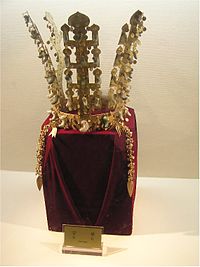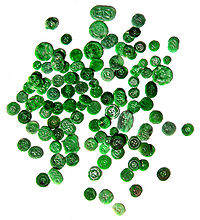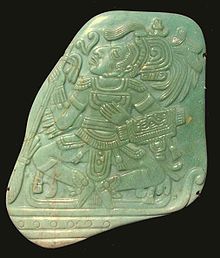- Jade
-
Jade is an ornamental stone. The term jade is applied to two different metamorphic rocks that are made up of different silicate minerals:
- Nephrite consists of a microcrystaline interlocking fibrous matrix of the calcium, magnesium-iron rich amphibole mineral series tremolite (calcium-magnesium)-ferroactinolite (calcium-magnesium-iron). The middle member of this series with an intermediate composition is called actinolite (the silky fibrous mineral form is one form of asbestos). The higher the iron content the greener the colour.
- Jadeite is a sodium- and aluminium-rich pyroxene. The gem form of the mineral is a microcrystaline interlocking crystal matrix.
Contents
Etymology
The English word jade (alternative spellings "jaid", "jadeite") is derived (via French l'ejade and Latin ilia[1]) from the Spanish term piedra de ijada (first recorded in 1565) or "loin stone", from its reputed efficacy in curing ailments of the loins and kidneys. Nephrite is derived from lapis nephriticus, the Latin version of the Spanish piedra de ijada.[2] In some countries, jade is more commonly known as 'greenstone'.
Overview
Nephrite versus jadeite
Nephrite and jadeite were used from prehistoric periods for hardstone carving. Jadeite has about the same hardness as quartz, while nephrite is somewhat softer. Both nephrite and jadeite are tough, but jadeite is tougher than nephrite.[citation needed] It was not until the 19th century that a French mineralogist determined that "jade" was in fact two different materials.
Among the earliest known jade artifacts excavated from prehistoric sites are simple ornaments with bead, button, and tubular shapes.[3] Additionally, jade was used for axe heads, knives, and other weapons, which can be delicately shaped. As metal-working technologies became available, the beauty of jade made it valuable for ornaments and decorative objects. Jadeite measures between 6.5 and 7.0 Mohs hardness, and Nephrite between 5.5 and 6.0,[4] so it can be worked with quartz or garnet sand, and polished with bamboo or even ground jade.
Unusual varieties
Nephrite can be found in a creamy white form (known in China as "mutton fat" jade) as well as in a variety of green colours, whereas jadeite shows more colour variations, including blue, lavender-mauve, pink, and emerald-green colours. Of the two, jadeite is rarer, documented in fewer than 12 places worldwide. Translucent emerald-green jadeite is the most prized variety, both historically and today. As "quetzal" jade, bright green jadeite from Guatemala was treasured by Mesoamerican cultures, and as "kingfisher" jade, vivid green rocks from Burma became the preferred stone of post-1800 Chinese imperial scholars and rulers. Burma (Myanmar) and Guatemala are the principal sources of modern gem jadeite. In the area of Mogaung in the old Myitkyina District of Upper Burma (Myanmar), jadeite formed a layer in the dark-green serpentine, and has been quarried and exported for well over a hundred years.[5] Canada provides the major share of modern lapidary nephrite. Nephrite jade was used mostly in pre-1800 China as well as in New Zealand, the Pacific Coast and Atlantic Coasts of North America, Neolithic Europe, and Southeast Asia. In addition to Mesoamerica, jadeite was used by Neolithic Japanese and European cultures.
History
Prehistoric and historic China
During Neolithic times, the key known sources of nephrite jade in China for utilitarian and ceremonial jade items were the now depleted deposits in the Ningshao area in the Yangtze River Delta (Liangzhu culture 3400–2250 BC) and in an area of the Liaoning province and Inner Mongolia (Hongshan culture 4700–2200 BC).[6] Dushan Jade was being mined as early as 6000 BC. In the Yin Ruins of the Shang Dynasty (1600 BC to 1050 BC) in Anyang, Dushan Jade ornaments were unearthed in the tomb of the Shang kings. Jade was used to create many utilitarian and ceremonial objects, from indoor decorative items to jade burial suits. Jade was considered the "imperial gem". From the earliest Chinese dynasties to the present, the jade deposits most in use were not only those of Khotan in the Western Chinese province of Xinjiang but other parts of China as well, such as Lantian, Shaanxi. There, white and greenish nephrite jade is found in small quarries and as pebbles and boulders in the rivers flowing from the Kuen-Lun mountain range eastward into the Takla-Makan desert area. The river jade collection is concentrated in the Yarkand, the White Jades (Yurungkash) and Black Jade (Karakash) Rivers. From the Kingdom of Khotan, on the southern leg of the Silk Road, yearly tribute payments consisting of the most precious white jade were made to the Chinese Imperial court and there worked into objets d'art by skilled artisans as jade had a status-value exceeding that of gold or silver. Jade became a favorite material for the crafting of Chinese scholars' objects, such as rests for calligraphy brushes, as well as the mouthpieces of some opium pipes, due to the belief that breathing through jade would bestow longevity upon smokers who used such a pipe.[7]
Jadeite, with its bright emerald-green, pink, lavender, orange and brown colours was imported from Burma to China only after about 1800. The vivid green variety became known as Feicui (翡翠) or Kingfisher (feathers) Jade. It quickly became almost as popular as nephrite and a favorite of Qing Dynasty's nouveau riche, while scholars still had strong attachment to nephrite (white jade, or Khotan), which they deem as the symbol of a nobleman.
In the history of the art of the Chinese empire, jade has had a special significance, comparable with that of gold and diamonds in the West.[8] Jade was used for the finest objects and cult figures, and for grave furnishings for high-ranking members of the imperial family.[8] Due to that significance and the rising middle class in China, today the finest jade when found in nuggets of “mutton fat” jade — so-named for its marbled white consistency — can fetch $3,000 an ounce, a tenfold increase from a decade ago.[9]
Prehistoric and historic India
The Jainist temple of Kolanpak in the Nalgonda district, Andhra Pradesh, India is home to a 5-foot (1.5 m) high sculpture of Mahavira that is carved entirely out of jade. It is the largest sculpture made from a single jade rock in the world. India is also noted for its craftsman tradition of using large amounts of green serpentine or false jade obtained primarily from Afghanistan in order to fashion jewelry and ornamental items such as sword hilts and dagger handles.[5]
Prehistoric and early historic Korea
 Korean National Treasure No. 191, a gold crown with comma-shaped jades, was excavated from the Heavenly Horse Tomb of Silla and dates to the 5th century AD.
Korean National Treasure No. 191, a gold crown with comma-shaped jades, was excavated from the Heavenly Horse Tomb of Silla and dates to the 5th century AD.
The use of jade and other greenstone was a long-term tradition in Korea (c. 850 BC – AD 668). Jade is found in small numbers of pit-houses and burials. The craft production of small comma-shaped and tubular "jades" using materials such as jade, microcline, jasper, etc., in southern Korea originates from the Middle Mumun Pottery Period (c. 850–550 BC).[10] Comma-shaped jades are found on some of the gold crowns of Silla royalty (c. AD 300/400–668) and sumptuous elite burials of the Korean Three Kingdoms. After the state of Silla united the Korean Peninsula in AD 668, the widespread popularisation of death rituals related to Buddhism resulted in the decline of the use of jade in burials as prestige mortuary goods.
Māori
Nephrite jade in New Zealand is known as pounamu in the Māori language (often called "greenstone" in New Zealand English), and plays an important role in Māori culture. It is considered a taonga, or treasure, and therefore protected under the Treaty of Waitangi, and the exploitation of it is restricted and closely monitored. It is found only in the South Island of New Zealand, known as Te Wai Pounamu in Māori—"The [land of] Greenstone Water", or Te Wahi Pounamu—"The Place of Greenstone".
Tools, weapons and ornaments were made of it; in particular adzes, the 'mere' (short club), and the Hei-tiki (neck pendant). These were believed to have their own mana, handed down as valuable heirlooms, and often given as gifts to seal important agreements. Nephrite jewellery of Maori design is widely popular with locals and tourists, although some of the jade used for these is now imported from British Columbia and elsewhere.[11]
Mesoamerica
Jade was a rare and valued material in pre-Columbian Mesoamerica. The only source from which the various indigenous cultures, such as the Olmec and Maya, could obtain jade was located in the Motagua River valley in Guatemala. Jade was largely an elite good, and was usually carved in various ways, whether serving as a medium upon which hieroglyphs were inscribed, or shaped into symbolic figurines. Generally, the material was highly symbolic, and it was often employed in the performance of ideological practices and rituals.
Enhancement
Jade may be enhanced (sometimes called "stabilized"). Note that some merchants will refer to these as Grades, but it is important to bear in mind that degree of enhancement is different from colour and texture quality. In other words, Type A jadeite is not enhanced but can have poor colour and texture. There are three main methods of enhancement, sometimes referred to as the ABC Treatment System:[12]
- Type A jadeite has not been treated in any way except surface waxing.
- Type B treatment involves exposing a promising but stained piece of jadeite to chemical bleaches and/or acids and impregnating it with a clear polymer resin. This results in a significant improvement of transparency and colour of the material. Currently, infrared spectroscopy is the most accurate test for the detection of polymer in jadeite.
- Type C jade has been artificially stained or dyed. The effects are somewhat uncontrollable and may result in a dull brown. In any case, translucency is usually lost.
- B+C jade is a combination of B and C: it has been both artificially dyed AND impregnated.
- Type D jade refers to a composite stone such as a doublet comprising a jade top with a plastic backing.
See also
- Costa Rican jade tradition
- False Jade or Serpentine
- Heavenly Horse Tomb, a Silla royal tomb in Korea with jade artifacts.
- Jade burial suit
- Mumun Pottery Period, the time in Korea when jade ornament production began
- Pounamu
Notes
- ^ "Online Etymology Dictionary". Etymonline.com. http://www.etymonline.com/index.php?term=jade. Retrieved 2011-03-07.
- ^ Easby, Elizabeth Kennedy. Pre-Colombian Jade from Costa Rica. (1968). André Emmerich Inc., New York
- ^ Liu, Li. The Products of Minds as Well as Hands: Production of Prestige Goods in Neolithic and Early State Periods of China. Asian Perspectives 42(1):1-40, 2003, pg 2.
- ^ [1][dead link] Orionsgemz.com Retrieved on 06-01-07
- ^ a b Hunter, Sir William Wilson and Burn, Sir Richard, The Imperial Gazeteer of India, Vol. 3, Oxford, England: Clarendon Press, Henry Frowde Publishers (1907), p. 242
- ^ Liu, Li 2003:3-15
- ^ Martin, Steven. The Art of Opium Antiques. Silkworm Books, Chiang Mai, 2007
- ^ a b Jade. Gemstone.org
- ^ NYtimes.com
- ^ Bale, Martin T. and Ko, Min-jung. Craft Production and Social Change in Mumun Pottery Period Korea. Asian Perspectives 45(2):159-187, 2006.
- ^ Salt, Donn, 1992, Stone, Bone and Jade - 24 New Zealand Artists, David Bateman Ltd, Auckland.
- ^ Tay Thye Sun, The Changing Face of Jade, Swiss Gemmological Inst., SSEF Alumni Newsletter No. 3, pp. 5 - 6
References
- Scott-Clark, Cathy and Levy, Adrian (2002). The Stone of Heaven: Unearthing the Secret History of Imperial Green Jade. Boston: Little, Brown and Co. ISBN 0316525960, ISBN 0316095583. OCLC 52256304.
Further reading
- Laufer, Berthold, 1912, Jade: A Study in Chinese Archeology & Religion, Reprint: Dover Publications, New York. 1974.
- Rawson, Jessica, 1975, Chinese Jade Throughout the Ages, London: Albert Saifer, ISBN 0-87556-754-1
- Jadeite sources in Mesoamerica (PDF)
- Between hell and the Stone of Heaven: Observer article on Jade Mining in Burma
- Old Chinese Jades: Real or Fake?
- Book review, The Stone of Heaven: The Secret History of Imperial Green Jade by Adrian Levy and Cathy Scott-Clark
External links
- Gemstone at the Open Directory Project
- The British Museum - 7,000 years of Chinese jade
- Gravity Measurement For Testing Jade (2008 archived version)
- mindat.org (Mineralogical data about Jade)
- Jade in Canada
- "Jade in British Columbia table", BC Govt MINFILE summary of jade showings and producers
- Canadian Rockhound magazine feature on jade
- "Guatemalan Jadeite", Precolumbian Replicas and Fine Jewelry
Jewellery Forms Anklet · Belt buckle · Belly chain · Bindi · Bracelet · Brooch · Chatelaine · Collar pin · Crown · Cufflink · Earring · Lapel pin · Necklace · Pendant · Ring · Tiara · Tie clip · Toe ring · Watch (pocket)Making PeopleProcessesCasting (centrifugal, lost-wax, vacuum) · Enameling · Engraving · Filigree · Metal clay · Plating · Polishing · Repoussé and chasing · Soldering · Stonesetting · Wire wrappingToolsMaterials Britannia silver · Colored gold · Crown gold · Electrum · Platinum sterling · Shakudo · Shibuichi · Sterling silver · TumbagaMineral gemstonesAventurine · Agate · Alexandrite · Amethyst · Aquamarine · Carnelian · Citrine · Diamond · Diopside · Emerald · Garnet · Jade · Jasper · Lapis lazuli · Larimar · Malachite · Marcasite · Moonstone · Obsidian · Onyx · Opal · Peridot · Quartz · Ruby · Sapphire · Sodalite · Sunstone · Tanzanite · Tiger's eye · Topaz · Tourmaline · TurquoiseOrganic gemstonesTerms Categories:- Chinese culture
- Gemstones
- Provincial symbols of British Columbia
- Inosilicates
- Hardstone carving
- Shades of green
- Jade
Wikimedia Foundation. 2010.





